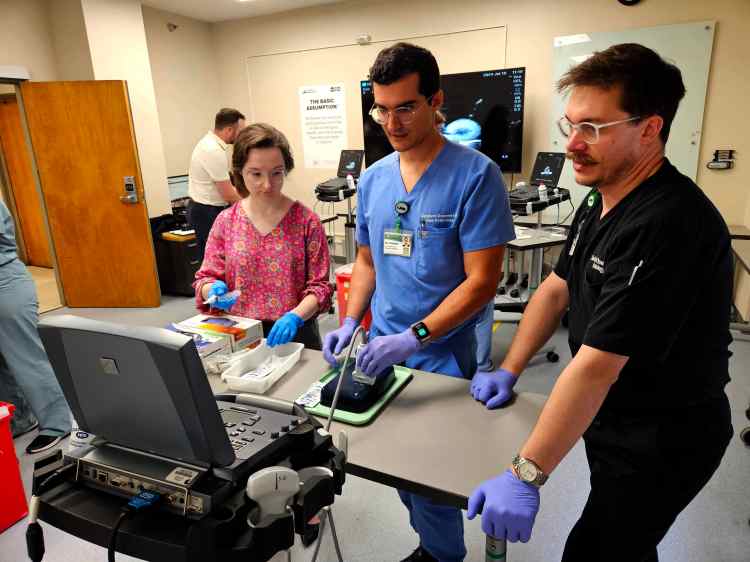Procedure meets precision at UAB Clinical Simulation

At UAB Clinical Simulation, procedural simulation is more than just a modality; it’s a shared vision for elevating clinical practice across UAB Medicine.
The center’s procedural simulation program aims to establish evidence-based, standardized training modules for every procedure performed across the health system. The goal is to see these modules used across multiple professions, helping define—and reinforce—an institutional standard, i.e., the “UAB Way.”
And in true UAB fashion, that standard is steeped in interprofessionalism.
“Procedural simulation reflects a deeply interprofessional effort,” said Lisa Bergman, director of procedural simulation for UAB Clinical Simulation. “Clinical experts from a range of disciplines collaborate with simulationists and educators to define, refine and deploy high-quality training.”
As such, every procedural simulation experience—from ultrasound-guided peripheral IV to central venous line insertions to fine needle aspiration and beyond—aligns with the “Learn-See-Practice-Prove-Do-Maintain” framework, ensuring learners progress through a structured and research-backed approach to skill acquisition.
Success is dependent on interprofessional participation, and providers and staff from across UAB Medicine are invited—and encouraged—to participate as learners and facilitators.
The procedural simulation team collaborates with UAB providers and staff to develop simulation-based training that is pertinent to their clinical practice areas, whether intended to provide initial exposure to the process of a procedure, to practice rare or risky procedures or for ongoing maintenance of procedural skills.
Additionally, the team works with those interested in facilitating simulation to help them develop the skills associated with using simulation as a teaching tool for an ever-growing catalog of procedures—both in and out of the lab.
Equipment Loans
One of the most widely used services offered by UAB Clinical Simulation is the equipment loan program, which allows UAB Medicine partners to borrow a variety of task trainers and simulation equipment for out-of-lab education—free of charge.
With an array of simulators available, the team works closely with various departments to match learners with the tools that best support their educational objectives.
“Whether it’s a foley trainer or an arrhythmia simulator, our team works hard to source what departments need, sometimes purchasing or even creating specialty items when no ready-made option exists,” Bergman said.
For instance, when there is not a commercially available trainer that provides the experience or feedback required, procedural team members flex their creativity to modify existing trainers or develop new ones altogether.
Sarah Shipley, nursing professional development specialist with the UAB Hospital Emergency Department, routinely uses the equipment loan program to assist with Emergency Services’ yearly competencies, checking out crash carts, defibrillators, ABG trainers, foley trainers and more.
“If there is something that is not available, Clinical Simulation has worked to make it available for us—either through buying or making it,” Shipley said.
Independent Study
Procedural simulation also allows learners to practice independently through Clinical Simulation’s Independent Simulator Study Lab (ISSL). Located in Quarterback Tower Room 202 and accessible to anyone with UAB Hospital badge access, the ISSL allows learners to practice independently on a growing suite of high-fidelity simulators, made possible through generous grant-funded support and partnerships across UAB Medicine.
“Our goal is to provide the highest quality simulation tools and tactics so that everyone in the UAB Health System can practice and test their skills,” said Marjorie Lee White, M.D., vice president of UAB Clinical Simulation.
Current simulators include:
- Simbionix LAP Mentor, supporting basic to advanced laparoscopic skills
- Simbionix GI-BRONCH Mentor, enabling training in GI endoscopy and flexible bronchoscopy
- CAE Vimedix, with modules for cardiac, lung, abdominal and OB-GYN ultrasound
- ORSIM Bronch Trainer, offering a wide range of virtual upper-airway scenarios
And More
From supply chain teams to clinical educators to simulationists, procedural simulation at UAB is a deeply interprofessional enterprise, Bergman said.
“The success of every experience depends on contributions from departments across the health system,” she added. “Together, these teams help define the ‘UAB Way’ and ensure high-quality, standardized procedural education for all.”
Get Involved
To become involved in the procedural simulation process, simply reach out to simulation@uabmc.edu.
UAB Medicine’s Clinical Simulation program offers opportunities for individuals and teams across UAB Medicine and beyond to practice before they deliver care. We encourage all who provide and support patient care to “Sim First.” Together, we can put our patients’ safety first.




0 Comments